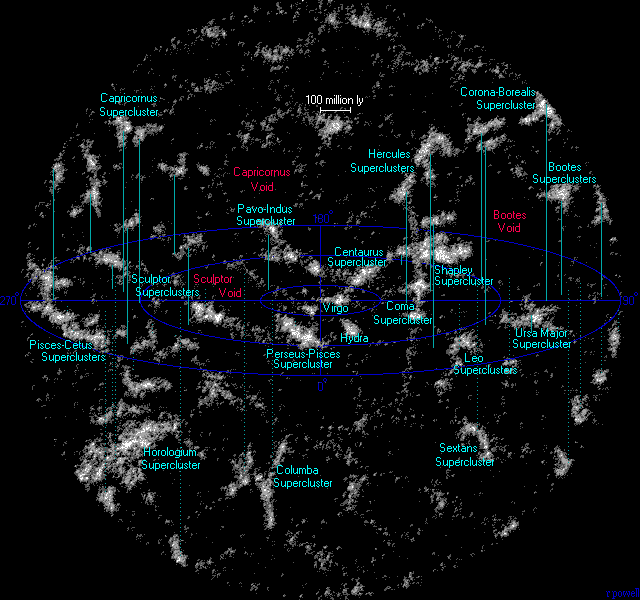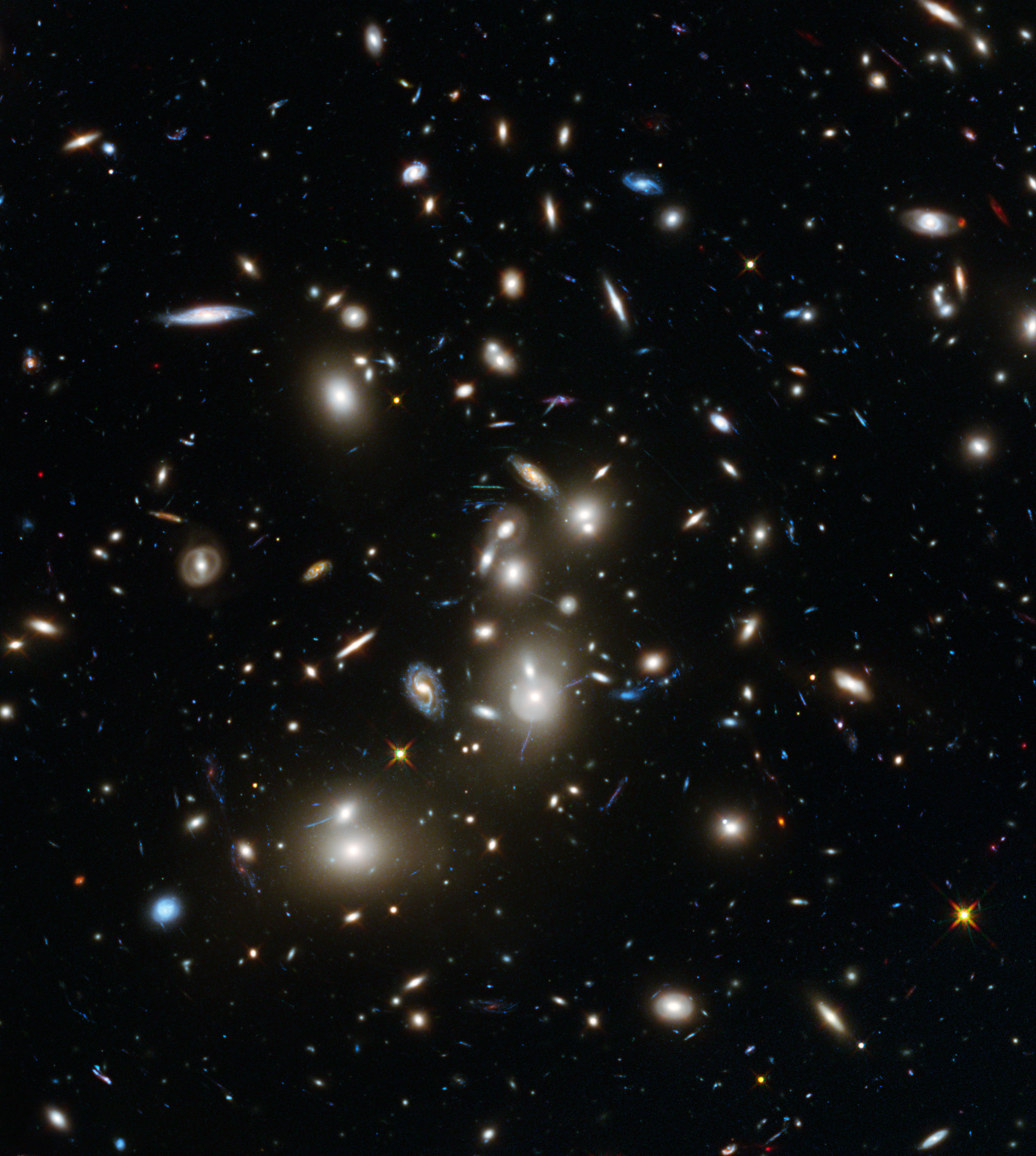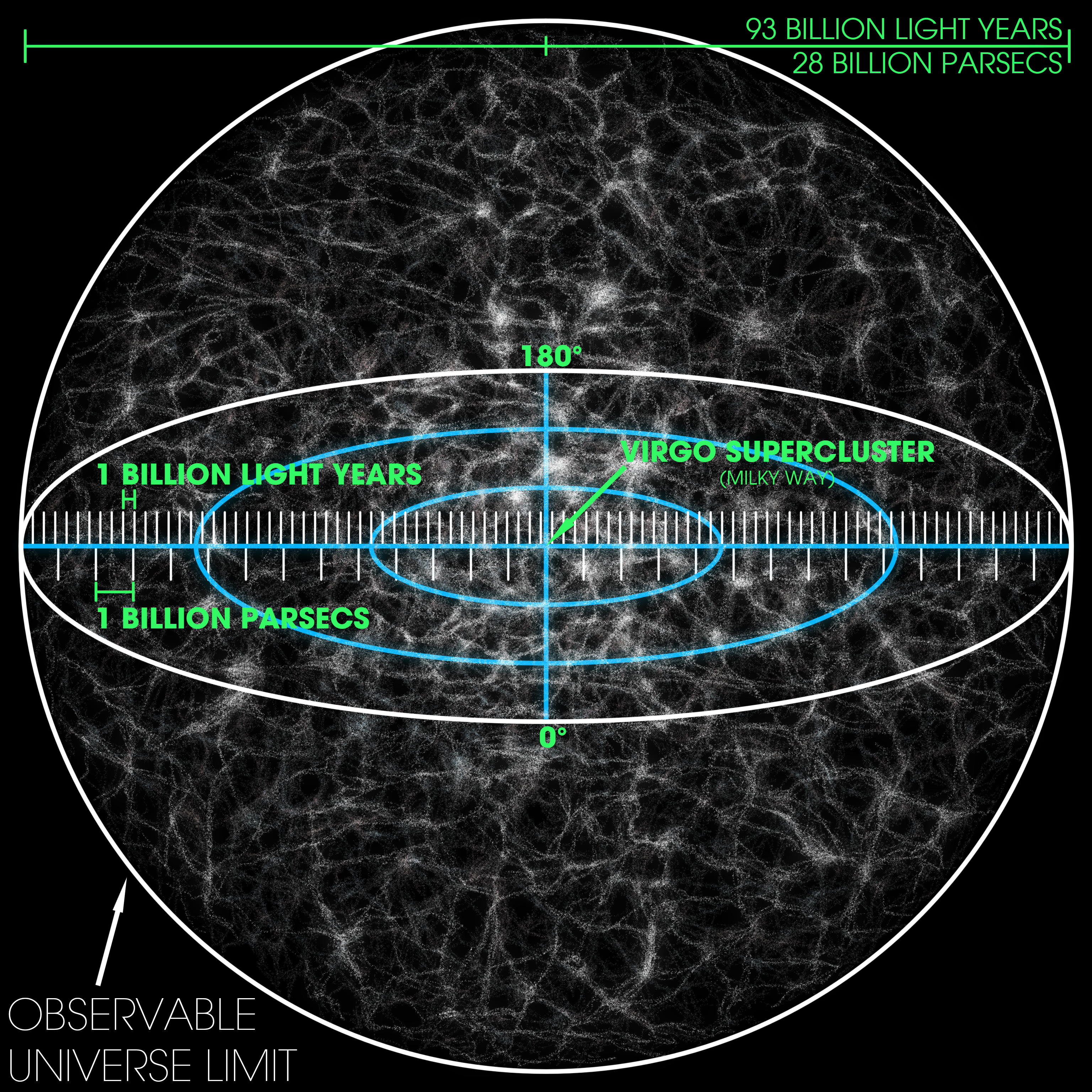|
Horologium-Reticulum Supercluster
The Horologium-Reticulum Supercluster, is a massive supercluster spanning around 550 million light-years. It has a mass of around 1017 solar masses, similar to that of the Laniakea Supercluster, which houses the Milky Way. It is centered on coordinates right ascension and declination , and spans an angular area of 12° × 12°. The nearest part of the supercluster is 700 million light-years away from Earth, while the far end of it is 1.2 billion light-years. It is visible in the constellations Horologium and Eridanus. The Horologium Supercluster has about 5,000 galaxy groups (30,000 giant galaxies and 300,000 dwarf galaxies). It includes the galaxy cluster Abell 3266. Gallery Horologium_reticulum_supercluster.png, Axonometric representation of the Horologium-Reticulum Supercluster See also * Abell catalog * Large scale structure of the universe * List of Abell clusters The Abell catalogue is a catalogue of approximately 4,000 galaxy clusters with at least 30 membe ... [...More Info...] [...Related Items...] OR: [Wikipedia] [Google] [Baidu] |
Supercluster
A supercluster is a large group of smaller galaxy clusters or galaxy groups; they are among the largest known structures in the universe. The Milky Way is part of the Local Group galaxy group (which contains more than 54 galaxies), which in turn is part of the Virgo Supercluster, which is part of the Laniakea Supercluster."Earth's new address: 'Solar System, Milky Way, Laniakea ''Nature (journal), Nature'' The large size and low density of superclusters means that they, unlike clusters, expand with the Hubble expansion. The number of superclusters in the observable universe is estimated to be 10 million. Existence [...More Info...] [...Related Items...] OR: [Wikipedia] [Google] [Baidu] |
Galaxy Group
A galaxy group or group of galaxies (GrG) is an aggregation of galaxies comprising about 50 or fewer gravitationally bound members, each at least as luminous as the Milky Way (about 1010 times the luminosity of the Sun); collections of galaxies larger than groups that are first-order clustering are called galaxy clusters. The groups and clusters of galaxies can themselves be clustered, into superclusters of galaxies. The Milky Way galaxy is part of a group of galaxies called the Local Group. Characteristics Groups of galaxies are the smallest aggregates of galaxies. They typically contain no more than 50 galaxies in a diameter of 1 to 2 megaparsecs (Mpc).see 1022 m for distance comparisons Their mass is approximately 1013 solar masses. The spread of velocities for the individual galaxies is about 150 km/s. However, this definition should be used as a guide only, as larger and more massive galaxy systems are sometimes classified as galaxy groups. Groups are the most commo ... [...More Info...] [...Related Items...] OR: [Wikipedia] [Google] [Baidu] |
List Of Largest Cosmic Structures
This is a list of the largest cosmic structures so far discovered. The unit of measurement used is the light-year (distance traveled by light in one Julian year; approximately 9.46 trillion kilometres). This list includes superclusters, galaxy filaments and large quasar groups (LQGs). The list characterizes each structure based on its longest dimension. Note that this list refers only to coupling of matter with defined limits, and not the coupling of matter in general (as per example the cosmic microwave background, which fills the entire universe). All structures in this list are defined as to whether their presiding limits have been identified. There are some speculations about this list: *The Zone of Avoidance, or the part of the sky occupied by the Milky Way, blocks out light to several structures, making their limits imprecisely identified. *Some structures are far too distant to be seen even with the most powerful telescopes. Some factors are included to explain the str ... [...More Info...] [...Related Items...] OR: [Wikipedia] [Google] [Baidu] |
List Of Superclusters
A supercluster is a large group of smaller galaxy clusters or galaxy groups; they are among the largest known structures in the universe. The Milky Way is part of the Local Group galaxy group (which contains more than 54 galaxies), which in turn is part of the Virgo Supercluster, which is part of the Laniakea Supercluster."Earth's new address: 'Solar System, Milky Way, Laniakea '''' The large size and low density of superclusters means that they, unlike clusters, expand with the Hubble expansion. The number of superclusters in th ... [...More Info...] [...Related Items...] OR: [Wikipedia] [Google] [Baidu] |
List Of Abell Clusters
The Abell catalogue is a catalogue of approximately 4,000 galaxy clusters with at least 30 members, almost complete to a redshift of ''z'' = 0.2. It was originally compiled by the American astronomer George O. Abell in 1958 using plates from POSS, and extended to the southern hemisphere by Abell, Corwin and Olowin in 1987. The name "Abell" is also commonly used as a designation for objects he compiled in a catalogue of 86 planetary nebulae in 1966. The proper designation for the galaxy clusters is ACO, as in "ACO 13", while the planetary-nebula designation is the single letter A, as in "A 39". 1–1999 2000–4076 Southern catalogue S1–S1174 See also * Lists of astronomical objects * List of galaxy groups and clusters This article lists some galaxy groups and galaxy clusters. Defining the limits of galaxy clusters is imprecise as many clusters are still forming. In particular, clusters close to the Milky Way tend to be classified as galaxy clusters eve ... [...More Info...] [...Related Items...] OR: [Wikipedia] [Google] [Baidu] |
Observable Universe
The observable universe is a ball-shaped region of the universe comprising all matter that can be observed from Earth or its space-based telescopes and exploratory probes at the present time, because the electromagnetic radiation from these objects has had time to reach the Solar System and Earth since the beginning of the cosmological expansion. There may be 2 trillion galaxies in the observable universe, although that number was reduced in 2021 to only several hundred billion based on data from '' New Horizons''. Assuming the universe is isotropic, the distance to the edge of the observable universe is roughly the same in every direction. That is, the observable universe is a spherical region centered on the observer and is unique for every unique observational position. The word ''observable'' in this sense does not refer to the capability of modern technology to detect light or other information from an object, or whether there is anything to be detected. It refers to the ... [...More Info...] [...Related Items...] OR: [Wikipedia] [Google] [Baidu] |
Abell Catalog
The Abell catalog of rich clusters of galaxies is an all-sky catalog of 4,073 rich galaxy clusters of nominal redshift ''z'' ≤ 0.2. This catalog supplements a revision of George O. Abell's original "Northern Survey" of 1958, which had only 2,712 clusters, with a further 1,361 clustersthe "Southern Survey" of 1989, published after Abell's death by co-authors Harold G. Corwin and Ronald P. Olowin from those parts of the south celestial hemisphere that had been omitted from the earlier survey. The Abell catalog, and especially its clusters, are of interest to amateur astronomers as challenge objects to be viewed in dark locations on large aperture amateur telescopes. The Northern Survey The original catalog of 2,712 rich clusters of galaxies was published in 1958 by George O. Abell (1927–1983), who was then studying at the California Institute of Technology. The catalog, which formed part of Abell's PhD thesis, was prepared by means of a visual inspection of the ... [...More Info...] [...Related Items...] OR: [Wikipedia] [Google] [Baidu] |
Axonometry
Axonometry is a graphical procedure belonging to descriptive geometry that generates a planar image of a three-dimensional object. The term "axonometry" means "to measure along axes", and indicates that the dimensions and scaling of the coordinate axes play a crucial role. The result of an axonometric procedure is a uniformly-scaled parallel projection of the object. In general, the resulting parallel projection is oblique (the rays are not perpendicular to the image plane); but in special cases the result is orthographic (the rays are perpendicular to the image plane), which in this context is called an orthogonal axonometry. In technical drawing and in architecture, axonometric perspective is a form of two-dimensional representation of three-dimensional objects whose goal is to preserve the impression of volume or relief. Sometimes also called rapid perspective or artificial perspective, it differs from conical perspective and does not represent what the eye actually sees: in ... [...More Info...] [...Related Items...] OR: [Wikipedia] [Google] [Baidu] |
Abell 3266
Abell 3266 is a galaxy cluster in the southern sky. It is part of the Horologium-Reticulum Supercluster. The galaxy cluster is one of the largest in the southern sky, and one of the largest mass concentrations in the nearby universe. The Department of Physics at the University of Maryland, Baltimore County discovered that a large mass of gas is hurtling through the cluster at a speed of 750 km/s (466 miles/second). The mass is billions of solar masses, approximately 3 million light-years in diameter and is the largest of its kind discovered as of June 2006. See also * Abell catalogue * List of Abell clusters The Abell catalogue is a catalogue of approximately 4,000 galaxy clusters with at least 30 members, almost complete to a redshift of ''z'' = 0.2. It was originally compiled by the American astronomer George O. Abell in 1958 using plates from PO ... * X-ray astronomy References External links Abel 3266 on SIMBAD* Horologium Supercluster Galaxy clusters ... [...More Info...] [...Related Items...] OR: [Wikipedia] [Google] [Baidu] |
Dwarf Galaxies
A dwarf galaxy is a small galaxy composed of about 1000 up to several billion stars, as compared to the Milky Way's 200–400 billion stars. The Large Magellanic Cloud, which closely orbits the Milky Way and contains over 30 billion stars, is sometimes classified as a dwarf galaxy; others consider it a full-fledged galaxy. Dwarf galaxies' formation and activity are thought to be heavily influenced by interactions with larger galaxies. Astronomers identify numerous types of dwarf galaxies, based on their shape and composition. Formation One theory states that most galaxies, including dwarf galaxies, form in association with dark matter, or from gas that contains metals. However, NASA's Galaxy Evolution Explorer space probe identified new dwarf galaxies forming out of gases with low metallicity. These galaxies were located in the Leo Ring, a cloud of hydrogen and helium around two massive galaxies in the constellation Leo. Because of their small size, dwarf galaxies have bee ... [...More Info...] [...Related Items...] OR: [Wikipedia] [Google] [Baidu] |
Constellation
A constellation is an area on the celestial sphere in which a group of visible stars forms Asterism (astronomy), a perceived pattern or outline, typically representing an animal, mythological subject, or inanimate object. The origins of the earliest constellations likely go back to prehistory. People used them to relate stories of their beliefs, experiences, creation myth, creation, or mythology. Different cultures and countries adopted their own constellations, some of which lasted into the early 20th century before today's constellations were internationally recognized. The recognition of constellations has changed significantly over time. Many changed in size or shape. Some became popular, only to drop into obscurity. Some were limited to a single culture or nation. The 48 traditional Western constellations are Greek. They are given in Aratus' work ''Phenomena'' and Ptolemy's ''Almagest'', though their origin probably predates these works by several centuries. Constellation ... [...More Info...] [...Related Items...] OR: [Wikipedia] [Google] [Baidu] |
Horologium (constellation)
Horologium (Latin , the pendulum clock, from Ancient Greek, Greek , ) is a constellation of six stars faintly visible in the southern celestial hemisphere. It was first described by the French astronomer Nicolas-Louis de Lacaille in 1756 and visualized by him as a clock with a pendulum and a second hand. In 1922 the constellation was redefined by the International Astronomical Union (IAU) as a region of the celestial sphere containing Lacaille's stars, and has since been an IAU designated constellations, IAU designated constellation. Horologium's associated region is wholly visible to observers south of 23rd parallel north, 23°N. The constellation's brightest star—and the only one brighter than an apparent magnitude of 4—is Alpha Horologii (at 3.85), an aging orange giant star that has swollen to around 11 times the diameter of the Sun. The Mira variable, long-period variable-brightness star, R Horologii (4.7 to 14.3), has one of the largest variations in brightness among al ... [...More Info...] [...Related Items...] OR: [Wikipedia] [Google] [Baidu] |









